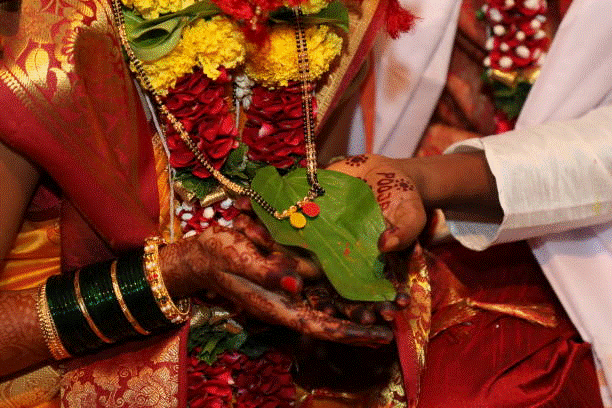All marriages have some ornament that represents that union. This ornament may take the form of a wedding ring, chain, nose piece, bangles, or even a toe ring. Mangalsutra is an Indian wedding chain and an ornament that symbolizes marriage.
Mangalsutra, also known as “mangalsutram,” is derived from the Sanskrit terms “mangal” (prosperous, blessed, happy, and successful) and “sutram” (cord). Ideally, it should be made of 108 (an auspicious number) fine cotton threads twisted together and dyed yellow in saffron or turmeric. A gold thali is strung in the middle of the thread.
When the groom wraps the mangalsutra around the bride’s neck and secures it with three knots, the priest recites mantras (chants). The act of tying one symbolizes that the groom and bride are together and have a duty to look after each other.
The mangalsutra is considered an auspicious amulet, and the bride herself is deemed to be auspicious (sumangala). The bride is said to become resistant to the evil eye by wearing it. Anyone who sees her is immediately bestowed with good fortune.
There are four main reasons for wearing a mangalsutra:
– The mangalsutra represents the union bond between Shiva (husband) and Shakti (wife). Essentially, it is an unbreakable bond between the husband and wife.
– Married women are supposed to wear the mangalsutra for the rest of their lives, as it is thought to improve the well-being of her husband and family.
– The three-knot links symbolize significant aspects of marriage. The first knot represents her husband’s obedience, the second knot represents her devotion to the husband’s parents, and the third knot represents her love for God.
– Mangalsutra is usually a black beaded chain made of thin gold wire. The gold wire and black beads are meant to dispel the distressing vibrations. The black beads absorb the harmful energy until it reaches the bride and her kin. The mangalsutra, in essence, functions as a protective sheath white chair covers for weddings around a woman’s body, shielding the marriage from any evil.
Mangalsutra Chain Length: The chain length of a mangalsutra was usually long enough to cross the bride’s Anahat Chakra, which is situated in the middle of the spine, near the heart. This means that the optimal chain length should be between 24 and 30 inches long. Anahat Chakra also means endless sound and is connected with harmony, calmness, and serenity.
Pendant: Small gold cup-like pendants are sometimes used. These are referred to as vatis. Many cultures prefer this as a universal mangalsutra pendant. Your mangalsutra may have either one or two vatis. Maharashtrians and Tamilians prefer two vatis.
The dome-shaped spherical vati is used because it emits the most waves as compared to other shapes. The vatis are aligned with the Anahata-Chakra. This aids in the release of a woman’s negative feelings, such as her ego. Although the mangalsutra is a typical wedding ornament, other types of wedding jewels exist.
A wedding ornament represents a woman who is married and comes from a specific cultural context. Wedding jewelry is an entry point into the complexities of Indian culture in several respects. It is an essential component of a man-woman relationship.
Even though some women never remove their mangalsutras, married women in cities have professional careers and do not like wearing traditional Indian jewelry, including mangalsutras, to work. Many jewelers make smaller petite and modern designs for them to fulfill their lifestyle. As a result, several variants of the mangalsutra principle mentioned above can exist.

